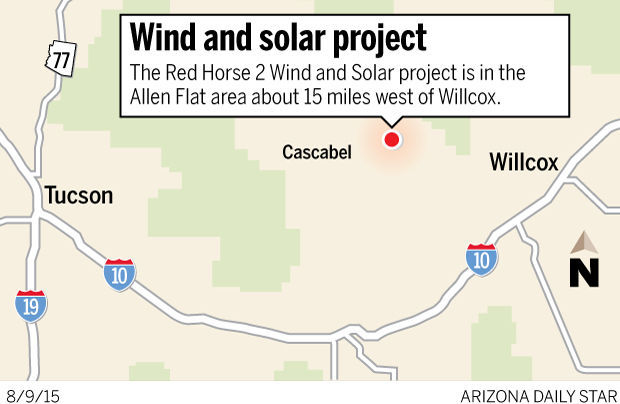Whenever the wind blows or the sun shines, a first-of-its kind renewable power plant near Willcox will help power thousands of Tucson homes.
The project, which will serve Tucson Electric Power Co., was dedicated last week amid cloudy skies and gusty winds in the rolling grasslands about 15 miles west of Willcox, despite lingering concerns over the impact of its massive wind turbines on migratory birds and other wildlife.
The more than $200 million Red Horse 2 Wind and Solar Project is the first utility-scale wind farm in Southern Arizona. It’s also one of a few combined wind and solar projects in the nation and the first in Arizona, according to developer D.E. Shaw Renewable Investments.
The overall project has a rated capacity of 71 megawatts (AC), including 30MW from 16 wind turbines. It’s expected to generate enough juice annually to power 13,500 TEP homes.
The turbines are roughly 450 feet tall, or more than 30 building stories — taller than downtown Tucson’s tallest building.
TEP has a 20-year contract to purchase power from the project, which developers say will cut carbon dioxide emissions by nearly 5 million metric tons over 30 years, or the equivalent of removing more than 1 million cars from the road.
“It’s a great opportunity,” said Carmine Tilghman, senior director of energy supply for TEP and its rural sister utility, UNS Electric. “This location is one of the largest, if not the largest, combined solar and wind site in the nation.”
Tilghman said the combination of wind and solar evens out the power flow to help manage the intermittency of the renewable resources.
“There are few locations in the country where you can get a reasonable resource for both wind and solar, so if you have that opportunity, they do work very well together based on production profiles.”
The stormy weather during the site’s dedication on Thursday illustrated that point, as the massive turbine blades swept through the air.
“We don’t have much sun today, but the wind makes up for it in spades,” said Jon Kilberg, president of Torch Renewable Energy.
Tilghman said TEP and its customers are getting a good deal, too. TEP will be paying just over 5 cents per kilowatt-hour for power produced at Red Horse 2, which even with transmission costs make it competitive with TEP’s other generating resources, he said.
TEP recently signed an agreement to expand the Red Horse 2 solar installation, Tilghman said. The solar array already spans some 650 acres a few miles west of the wind farm.
The cost of power purchase contracts for renewable-energy projects has declined steadily, from 10 cents or more per kWh just a few years ago to the 5-cent range now, Tilghman said.
Taxpayers are helping foot the bill for Red Horse 2. The project will qualify for a 30 percent federal investment tax credit, according to U.S. Bancorp, the project’s main financial backer. US Bank recently announced it had entered into a tax-equity syndication agreement with Zions Bank, parent of National Bank of Arizona, to help finance the project.
U.S. Bancorp says Red Horse 2 has created or will generate more than 800 construction and installation jobs and more than $110 million in economic impact from salaries, equipment purchases, construction materials and secondary spending.
The project is expected to produce $1.6 million in annual economic impact, according to U.S. Bancorp. Six to eight permanent operations and maintenance jobs are expected, according to project designer and builder Swinerton Renewable Energy.
Pat Call, chairman of the Cochise County Board of Supervisors, said the Red Horse 2 project will contribute property taxes as well as jobs to the local economy. Though most of the project sits on state trust land, it will be subject to personal-property taxes on equipment, for example.
“This is a rural county, a poor county, so that will be very useful,” said Call, who toured the project with other local officials during a ribbon-cutting event on Thursday.
“It’s also kind of neat to be part of the renewable-energy (movement),” he said. “This isn’t getting in anybody’s way out here.”
But not everyone is happy with Red Horse 2.
Environmental groups including the Audubon Society had objected to Cochise County’s approval of the wind installation before its potential danger to birds and other wildlife had been studied more thoroughly by the U.S. Fish and Wildlife Service. Though estimates vary widley, wind turbines have been blamed for the deaths of up to hundreds of thousands of birds annually.
The Red Horse project area is not far from a pair of nesting golden eagles, and environmentalists also are concerned about other raptors, sandhill cranes, and other birds and bats.
The area is part of a globally important migratory bird route that includes the San Pedro River and the Willcox Playa Wildlife Area, said Christina McVie, conservation chair of the Tucson Audubon Society.
“This is a hemispherically important area for species that migrate from South America to Alaska,” McVie said.
She said Audubon supports renewable energy, but more studies should have been done before the Red Horse 2 wind turbines were installed, to minimize their impact on wildlife.
“Configuration is really important, and the one thing we want to do is to avoid creating death traps where we don’t have to,” McVie said.
Though Cochise officials denied Audubon’s appeal of the permit approvals, the county supervisors added several conditions, including requiring the developer to take all reasonable steps to avoid bird deaths and to continue to share its environmental studies.
In cooperation with the U.S. Fish and Wildlife Service, Torch said earlier this year that it had performed bird counts and nest surveys and developed an eagle-conservation plan.






